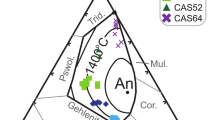Abstract.
This study examines the effects of increasing supersaturation, attained by single-step liquidus undercooling (ΔT), on the partitioning of barium and cesium between potassic alkali feldspar (Afs) and hydrous granitic liquid at 200 MPa. The investigation is motivated by trace-element distribution patterns in granitic pegmatites which cannot be simulated by fractionation models using "equilibrium" partition coefficients, and thus its purpose is to assess if, how, and why partition coefficients for compatible and incompatible trace elements may vary when crystal growth commences far from the crystal–melt equilibrium boundary. Barium expands the liquidus stability field of potassic feldspar to higher temperatures, such that liquidi for the Ba-rich (~0.5 wt% BaO) compositions used are ~100 °C higher than for Ba-absent analogues. At low degrees of undercooling (ΔT~50 °C), values of DBa Afs/m. (~10–20) fall within the range of previous investigations, as do values of DCs Afs/m. (≤0.10) from experiments at all temperatures. Progressively greater undercooling is manifested in the run products by increasingly skeletal to cuneiform crystal morphologies, increased compositional zonation of Afs, and the development of compositional boundary layers in glass. Whereas the partitioning behavior of Cs (incompatible) is not measurably affected, strong undercooling apparently causes the partitioning of Ba (highly compatible) to deviate from equilibrium behavior. Feldspars produced by strong undercooling (ΔT≥100 °C) are heterogeneous, such that DBa Afs/m. versus K/K+Na varies linearly between the average value at 850 °C and the equilibrium value appropriate to the temperature of growth. Hence, high supersaturation accompanying undercooling produces feldspar compositions by isothermal growth which record a vestige of the liquid line of descent (i.e., an ontogeny within zoned crystals which approximately tracks the feldspar liquidus from high temperature to the final low temperature of actual crystal growth). Such zoning patterns may mimic normal patterns produced by fractionation with decreasing temperature under near-equilibrium (near-liquidus) conditions. Increasing fluorine contents tend to exacerbate the effects of undercooling by inhibiting feldspar nucleation, causing both K/K+Na ratios and compatible trace-element partitioning behavior in feldspar to deviate from equilibrium values. This effect continues until nucleation lag is overcome, whereupon a period of rapid growth from supersaturated liquid follows which is similar to that in F-absent compositions. Electronic Supplementary Material to this paper can be obtained by using the Springer LINK server located at http://dx.doi.org/10.1008/s00410-002-425-y.
Similar content being viewed by others
Author information
Authors and Affiliations
Additional information
Electronic Publication
Rights and permissions
About this article
Cite this article
Morgan, G.B., London, D. Trace-element partitioning at conditions far from equilibrium: Ba and Cs distributions between alkali feldspar and undercooled hydrous granitic liquid at 200 MPa. Contrib Mineral Petrol 144, 722–738 (2003). https://doi.org/10.1007/s00410-002-0425-y
Received:
Accepted:
Issue Date:
DOI: https://doi.org/10.1007/s00410-002-0425-y




